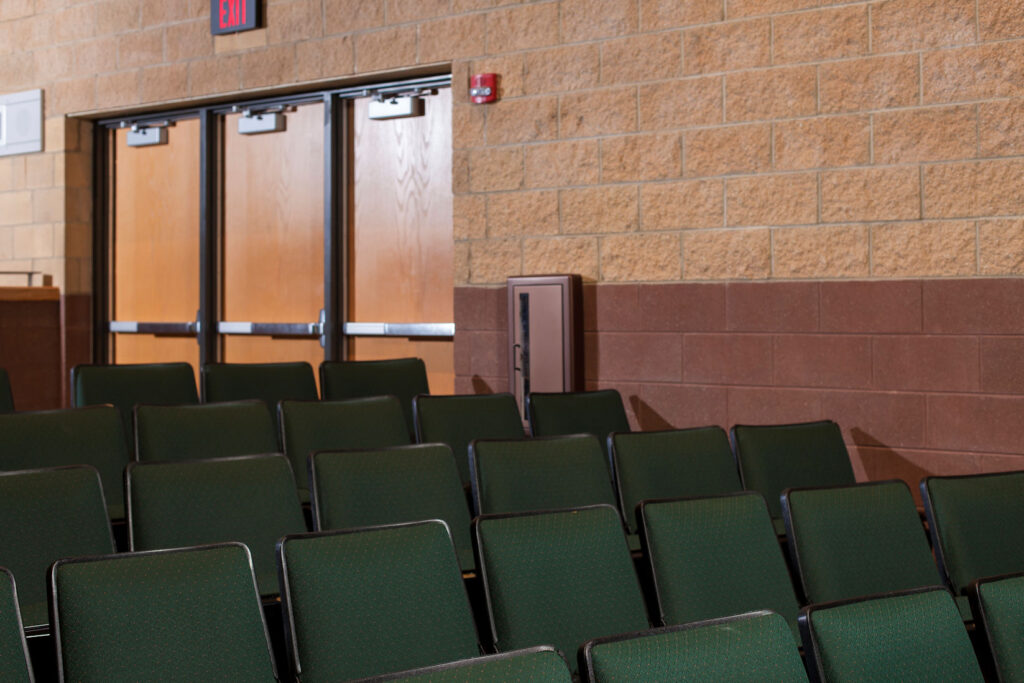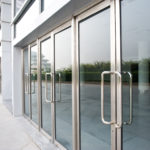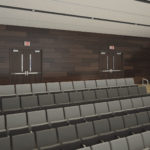My next Decoded article looks at some of the exceptions where doors serving assembly spaces are NOT required to have panic hardware. Did I miss any?
This post will be published in Doors & Hardware

Sometimes looking at a code question from a different perspective helps to form a better understanding of the requirements and the intent. Consider this question for a moment before moving on to the answer:
Question: Under what circumstances are doors serving assembly occupancies NOT required to be equipped with panic hardware?
 First, let’s look at where panic hardware IS required. There are two sets of model building codes and fire codes used in the U.S., and most states adopt one of these sets or a combination of the two, along with state modifications. The I-Codes include the International Building Code (IBC) and the International Fire Code (IFC). The National Fire Protection Association (NFPA) publishes more than 300 consensus codes and standards; the NFPA code most commonly used in the door and hardware industry is NFPA 101 – Life Safety Code.
First, let’s look at where panic hardware IS required. There are two sets of model building codes and fire codes used in the U.S., and most states adopt one of these sets or a combination of the two, along with state modifications. The I-Codes include the International Building Code (IBC) and the International Fire Code (IFC). The National Fire Protection Association (NFPA) publishes more than 300 consensus codes and standards; the NFPA code most commonly used in the door and hardware industry is NFPA 101 – Life Safety Code.
The model codes require panic hardware for doors serving the following occupancy types and calculated occupant loads:
I-Codes
- Assembly (Group A) and educational (Group E) occupancies, doors serving a calculated occupant load of 50 people or more
- High hazard occupancies (Group H), doors serving any occupant load
NFPA Codes
- Assembly, educational, and day care occupancies, doors serving a calculated occupant load of 100 people or more
- Areas of high hazard contents, doors serving an occupant load of more than 5 people
In some cases, panic hardware is also required for doors serving rooms that contain certain types of electrical equipment, and for refrigeration machinery rooms. Fire exit hardware is a type of panic hardware that is listed for use on a fire door assembly in addition to being listed as panic hardware. This article will address panic hardware in general, including devices listed only for panic and devices listed for panic and fire.
So, back to the question: For assembly occupancies, which doors would NOT require panic hardware?
No lock or latch. The panic hardware requirements of the model codes apply to doors serving the applicable areas when the door is equipped with locking or latching hardware. If the door has a push plate and a pull, for example, with no lock or latch, panic hardware would not be required – even when the door is serving one of the occupancy types and occupant loads stated above.
Low occupant load. A facility that is classified as an assembly occupancy may be divided into smaller spaces with a lower calculated occupant load. Imagine a conference center with meeting rooms of various sizes ranging from small conference rooms to large lecture halls. It’s likely that the doors serving the larger rooms would require panic hardware, while panic hardware would not be mandated for the smaller rooms with an occupant load of less than 50 people (I-Codes) or less than 100 people (NFPA codes).
Not a means of egress. The model codes handle the requirements for egress/non-egress doors slightly differently. The requirements of the I-Codes apply to doors that are required for egress, as well as doors that are provided for egress purposes. If there are “extra” doors, in quantities greater than the number of doors mandated by code, the requirements of the I-Codes must still be met if the doors are intended to be used for egress. If a door is not required for egress and not provided for egress purposes, the mandates of the I-Codes may not apply (verify with the authority having jurisdiction (AHJ)). The requirements of the NFPA codes are typically applied to doors that are part of the means of egress. The AHJ may allow panic hardware to be omitted if the doors are not required for egress nor provided for egress purposes. One example may be the inactive leaf of a pair if that leaf is not required for egress or intended to be used for egress, although this can be difficult to determine.
Main entrance doors. Both the I-Codes and the NFPA codes allow key-operated locks (double cylinder deadbolts) on the main entrance door(s) to a building or tenant space if certain criteria are met. The lock must be readily distinguishable as locked, and the door opening must have signage stating: “THIS DOOR TO REMAIN UNLOCKED WHEN THIS SPACE IS OCCUPIED.” The occupancy type must be one where a key-operated lock is allowed. For example, the I-Codes allow these locks on assembly occupancies with an occupant load of 300 people or less, business, factory, mercantile, and storage occupancies, and places of religious worship. The IBC Commentary states that the double-cylinder deadbolt addressed by this section is permitted as an alternative to panic hardware, allowing the panic hardware to be omitted. NFPA 101 includes a similar section allowing these locks where permitted by the occupancy chapters.
 Egress doors serving exterior spaces. The 2021 IBC and IFC include a new set of requirements that apply to egress doors serving enclosed exterior areas such as roof decks and courtyards, where the means of egress passes through the interior of the building. Similar to the main entrance doors addressed above, this section permits key-operated locks that are readily distinguishable as locked, along with the required signage. The I-Codes include additional requirements to ensure life safety for the occupants of these exterior spaces, such as a weatherproof telephone or two-way communication system in the exterior space, and a glazed vision panel or sidelight for observation of the outdoor area. The IBC Commentary states that the key-operated locks permitted by this section may be installed instead of panic hardware if all of the criteria are met. The 2021 edition of NFPA 101 does not include a similar section addressing these exterior spaces.
Egress doors serving exterior spaces. The 2021 IBC and IFC include a new set of requirements that apply to egress doors serving enclosed exterior areas such as roof decks and courtyards, where the means of egress passes through the interior of the building. Similar to the main entrance doors addressed above, this section permits key-operated locks that are readily distinguishable as locked, along with the required signage. The I-Codes include additional requirements to ensure life safety for the occupants of these exterior spaces, such as a weatherproof telephone or two-way communication system in the exterior space, and a glazed vision panel or sidelight for observation of the outdoor area. The IBC Commentary states that the key-operated locks permitted by this section may be installed instead of panic hardware if all of the criteria are met. The 2021 edition of NFPA 101 does not include a similar section addressing these exterior spaces.
Stadium gates. The I-Codes include a specific exception stating that panic hardware is not required on gates serving stadiums, if the gates are under constant supervision when the public is present. This exception also requires a safe dispersal area between the fence surrounding the stadium and the enclosed space. This area must provide at least 3 square feet per person and must be located at least 50 feet from the enclosed space (the stadium).
Conclusion
When determining whether a particular door requires panic hardware, the first question is which code has been adopted. Requirements vary between the two sets of model codes, there may be state or local modifications, and there are changes from one edition of the codes to the next. For example, if a state has adopted the 2018 I-Codes, the new section addressing egress doors serving exterior spaces does not apply, unless the AHJ approves a code modification.
Once the applicable code is identified, the next step is to verify the occupancy classification or use group and calculate the occupant load of the space. This information will determine whether or not panic hardware is mandated by code. If the door in question is serving a space that is required to have doors with panic hardware, the final step in the process is to decide whether any of the exceptions apply and whether all of the criteria listed in the applicable code are met. For assistance in interpreting the adopted code, consult with the AHJ.
You need to login or register to bookmark/favorite this content.










As for the “main entrance doors” paragraph… It aggravates me when the full glass main entrance double doors only have the deadbolt retracted on the active leaf. The inactive leaf usually has flushbolts and 99% of the time, the staff are either too lazy, or they were never properly instructed to retract the flushbolts in addition to the deadbolt. This is a pet peeve of mine. I have retracted plenty of flushbolts in my time because I have seen too many people push on the push bar on the inactive leaf, only to feel the glass with their face! I would say that restaurants are the biggest offenders.
In my opinion, they should have signage stating, “BOTH DOOR LEAFS MUST BE UNLOCKED AND FREE TO OPEN WHILE THIS BUILDING IS OCCUPIED”.
Hi Jerry –
We were just talking about that in a code development discussion. We feel your pain!
– Lori